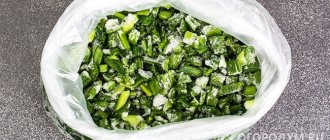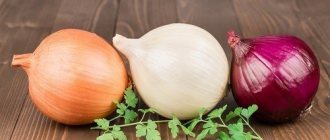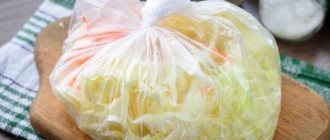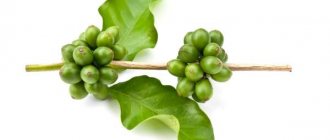Onions are a versatile vegetable, tasty, aromatic and very healthy. What can you cook from it? Yes, almost everything! Appetizers, soups, main dishes and even desserts, and they also bake bread with it. When making supplies for the winter, few housewives think about freezing onions, because they are stored for a long time and are sold in stores almost all year round. However, there are several reasons that justify such preparations.
“It is golden and elastic, a round onion is useful to everyone” - note that the heads of elongated oval, broadly ovoid, transversely elliptical and other shapes are no less useful
The first and main reason is the need to process the “substandard” part of the crop , which will not last long and will not have time to be used up. In addition, freezing onions for the winter in the freezer makes sense if:
There is no dry and cool cellar. Ideal conditions for preserving the harvest throughout the winter: temperature around 0 ℃, good ventilation and low humidity (you will also find detailed information about various methods of storing onions on the pages of our website).
Residents of ordinary apartments have probably encountered the problem of bulb germination. A week or two after purchase, they become soft to the touch, and green feathers appear instead of a dry tail.
Place the onion in a container filled with water with a neck of suitable diameter (so that only the lower half of the turnip is immersed in water) and place it on the kitchen windowsill.
Plastic egg trays are well suited as containers for forcing green feathers at home.
The green feathers will begin to grow actively, and within a few days you will be able to add fresh greens to your lunch or dinner. And, unfortunately, you will have to go to the store again to get new bulbs.
For those who are interested in the possibility of growing green onions on a windowsill, we suggest that you familiarize yourself with useful tips.
You cook a lot often. A lot of dishes (almost 90%) contain chopped onions in their recipes. Chopping takes a significant amount of time, and you have to “take extra measures” every time to cut raw onions without crying. Do you know how to do this and not cry? Here are a few secrets:
- if you have a gas stove or surface, turn on several burners before starting work; alternatively, you can light a candle;
- Chill the onion in the refrigerator for 30 minutes before slicing;
- periodically wet the knife blade with cold water;
- Take water into your mouth and hold until you have cut everything, or chew mint gum.
Another way is to choose sweet varieties, they are usually less tear-producing.
You don’t like the pungent smell and taste. In order to get rid of bitterness and the characteristic sharp taste, it is recommended to pre-marinate the vegetable or pour boiling water over it. Freezing saves the housewife from these problems, although the thawed product will no longer be as crispy.
Is it possible to freeze onions for the winter?
Not all housewives know whether they freeze onion slices for the winter. Like many other vegetables, turnips can be prepared for future use using low sub-zero temperatures (freezing). Before freezing onions, it is important to understand that exposure to sub-zero temperatures changes the vegetable somewhat.
When frozen, the crunchy elasticity that gives salads an interesting texture disappears. What remains retains the aromatic smell and specific taste with which the onion still enriches the dish, but after freezing it becomes soft.
Did you know? Chopped onions can be used to polish silverware and other metal objects to add brightness and shine.
Why freeze greens?
Nowadays, green onions can be purchased in stores at any time of the year, so is there any point in using them frozen? There are at least two reasons for this: first, greens are very expensive out of season, second, onions grown in greenhouses are inferior to their summer counterpart in both taste and aroma. Some housewives prefer to dry their produce, believing that after exposure to sub-zero temperatures, the onions will lose most of their vitamins, and the feathers, after defrosting, will stick together and lose their elasticity. To avoid such incidents, you need to approach freezing correctly.
The healing properties of feather onions are not lost when frozen. Vitamins are destroyed by exposure to high temperatures, air and light. Therefore, beneficial nutrients are more likely to suffer during the process of preservation and drying than from being in the freezer. The frozen vegetable contains vitamins A, C, E, K, group B, potassium, magnesium, calcium, phosphorus, sulfur, boron, cobalt, rubidium, copper, iron, chromium and other mineral elements. Adding such a product to food improves immunity and helps the body cope better with viruses during the cold season.
To obtain an all-season harvest of fresh greens, producers grow mainly spring onions rather than onions
How to choose and prepare onions correctly
To get high-quality frozen vegetables, you must adhere to several rules:
- Choose only fresh vegetables that have not lost their tissue density. The bulbs should not show rot or signs of fungus inside the bulb itself (black coating on the white flesh). There is nothing to worry about if the onion begins to sprout; in this case, it is quite suitable for freezing. Limp or drying vegetables are not suitable.
- After a thorough inspection, the bulbs are distributed according to their intended purpose: large and partially damaged ones - for slicing, small ones - for whole freezing. If the work is scheduled for the next day, the bulbs are taken out to a cool room overnight. This will make cutting the vigorous vegetable easier for the cook.
- Before cutting begins, the turnips are peeled, leaving the bottoms with roots intact, and washed well in several waters. The washed onions are laid out to dry for a couple of hours, after which they proceed directly to chopping. The consistency of grinding depends on the freezing method chosen by the cook.
Preparing the refrigerator or freezer before freezing
If the housewife’s plans already include freezing vegetables for the winter, she needs to prepare the freezer a few days before starting work:
- The freezer is turned off from electricity, emptied of food, and then washed well using detergents.
- If a foreign odor is firmly established in the freezer, you can wash the shelves and walls of the freezer with water to which baking soda has been added (1 tablespoon of soda per liter of water) or table vinegar (100 ml of vinegar per liter of water).
- The freezer is washed both inside and out, after which the household appliances are dried with the door open and turned off. The dry freezer is plugged in one day before freezing work begins. During this time, the freezer will again reach the desired temperature.
Important! If, after slicing, the onion smell has ingrained itself in the palms, wash them with warm water and any aromatic soap, then wipe the skin with a drop of lemon essential oil. In addition to the fact that this product will cleanse the skin of odor, the essential oil nourishes and moisturizes the nail plates.
Fragrance oil
Some housewives prepare fragrant butter for the winter, mixing it with herbs and spices in advance.
You will need:
- butter – soft, plastic, but not melted;
- green onions;
- any aromatic herbs to taste;
- spices - also to taste;
- a little salt.
Mix onions, herbs and oil, add spices and add a little salt so that the seasoning is not bland. Pack the product into bags or forms for freezing. If you are using ramekins, then remove the butter cubes and place in a vacuum sealed container.
We recommend: What is the best way to freeze raspberries for the winter?
The preparation can be added to soups and side dishes instead of regular oil. It’s very tasty to put pieces of this frozen food into cutlets or meat rolls - the dish turns out unusually juicy and aromatic.
Methods for freezing onions at home
Since large freezers appeared in homes, housewives have appreciated vegetable preparations. Onions can be frozen either in the form of chopped rings or cubes, or in the form of vegetable puree. After freezing, the vegetable does not lose its inherent aroma and taste, but irrevocably loses its elasticity.
Overall
You can freeze whole onions with or without blanching. Blanching is a culinary technique in which peeled vegetables are briefly immersed in boiling water. For small onions, blanching time is three minutes, for large ones - seven minutes. For proper freezing, blanching must warm the onion to the very middle.
Shredded in bags
To freeze a vegetable, you need to chop it. You can chop the onions using a regular knife slicer or place the vegetables in a food processor (blender). At the same time, the housewife needs to remember that thawed onions lose their shape, so after cutting in a food processor, the thawed product may resemble porridge. The slices are placed in plastic zip-up bags (with a zipper) and distributed inside in a thin layer.
Did you know? Onions contain flavonoids, unique compounds that are very beneficial for human health. The vegetable contains the biologically active compound quercetin, which is a powerful antioxidant with anti-cancer and anti-inflammatory effects.
Once frozen, the bag of slices will resemble a thick sheet of cardboard. If there are a lot of bags, they are stacked on top of each other (in a stack) in the freezer. You can also quickly freeze by placing the onion rings on a tray lined with parchment paper and placing them in the freezer. When the slices are frozen, they are packaged in freezer containers with lids or zip-up bags.
Fried
Before freezing, finely chopped onions can be fried until golden brown, that is, they can be caramelized before freezing. Frying is carried out over moderate heat in olive or fresh butter. The finished frying is cooled and packaged in a form for freezing ice. This type of vegetable freezing adds a new touch of flavor to the prepared food.
In ice trays
If the onion has sprouted and become soft, puree it in a blender or food processor with a small amount of olive (refined sunflower) oil. The resulting vegetable puree is placed in a mold for preparing ice cubes. When the onion cubes are frozen, store them in a container with a lid or in a ziplock bag. They are used as a seasoning for soup or sauce.
Important! The method of freezing vegetables in a bottle is also suitable for cutting green onions.
In a plastic bottle
You can also freeze onions in liter plastic bottles. In addition to being cheap, such a container is very convenient, since its neck acts as a dispenser and at the same time it closes tightly and hermetically. Only finely chopped slices are suitable for freezing in a bottle; the cut fraction should pass freely through the neck. Under no circumstances should you place vegetables chopped in a blender or food processor into the bottle.
The consistency of such grinding is more like a puree, and under the influence of low temperatures in the bottle you will get an ice monolith, which can only be removed completely and only after cutting the container. Freshly chopped onions cannot be immediately poured into a bottle and placed in the freezer for freezing. Beforehand, the slices are laid out on a tray in a thin layer and lightly frozen (until flowable). After this, the vegetable slices are poured into the neck of the bottle.
Important! Once any vegetables have been frozen, they will no longer be exactly the same as their fresh counterparts. After freezing, their tissue will be soft because the water inside the cells expanded and destroyed them when frozen.
To make it more convenient to pour frozen vegetables inside the bottle container, in the neck area the bottle is wrapped with food foil in the form of a funnel with a wide diameter. The cuttings are poured into this funnel. When filling, leave a few centimeters of free space between the lid and the vegetables, after which the bottle is tightly closed with a lid and placed in the freezer.
Video: how to freeze onions
Dried seasoning
Many people dry onions. To do this, the prepared feathers are finely chopped and stored in a dry, warm place with good ventilation. Make sure that the greens are not exposed to sunlight: they destroy vitamins. You can dry onion feathers under a canopy on the balcony or in the attic. After 3-4 days you will receive a fragrant seasoning. True, the aroma will change, and the spicy spiciness will disappear, but some people even like it.
It is better not to use dryers. At high temperatures and aggressive ventilation, the greens will dry out quickly, but will lose all their vitamins.
So, freezing green onions for the winter is a great idea. It will retain most of the nutrients and even after defrosting it will taste better than a feather grown on a windowsill in the cold season.
How to properly defrost and use onions
When it's time to use frozen vegetables, you just need to break off part of the frozen layer and defrost it if desired. Frozen onions defrost easily in the microwave or without it within a few minutes.
Many cooks are convinced that frozen vegetables absolutely do not need to be specially defrosted before adding them to any dish. The cook simply adds frozen cubes or pours the required portion of frozen onions directly into the food being prepared.
Young housewives may not know what can be prepared from it later. Freezing onions is best used for preparing first and second hot courses, various sauces, gravies, and marinades. This product is absolutely not suitable for adding to fresh vegetable salads or for frying.
You will be interested to know how to properly store onions in winter at home.
Ingredient for first courses
Frozen onions are an excellent addition to aromatic, just-boiled soup with meat or vegetable broth. Thanks to it, the broth becomes stronger, more aromatic, more beautiful and richer.
To make a delicious soup, simply add frozen onion cubes to cold water that already contains meat. Boil together with the meat pieces, and then add the remaining ingredients of the broth: vegetables, noodles, salt and spices.
Useful tips
How to make the cook’s job easier when freezing onions:
- To avoid tears when preparing sliced onions for freezing, it is advisable to cool the vegetable for 30 minutes before slicing. Peeling begins from the neck of the onion, without cutting off the root, but leaving it entirely. The root system will keep the onion from breaking into slices when chopping by hand. Sulfur compounds in onions, which are released when cells are destroyed (cutting), are concentrated in the area of the bottom of the onion, at the roots.
- You can also carry out all the work on chopping the caustic vegetable in the open air, so that the onion vapors overloaded with sulfur are neutralized by fresh air.
- Some chefs claim that a lit candle placed next to an onion board, the flame of which absorbs sulfur fumes, helps them avoid tears. There is no need to throw away the bottoms of already cut onions. At the end of the work, the roots are cut off and the remaining pulp is used to prepare a flavorful dish.
- Regardless of how the onions are frozen, they must be stored in an airtight container to prevent onion smell from appearing in the freezer. When packing cuttings into containers with lids, you should leave a couple of centimeters of free space. Layers of frozen vegetables in zip-up bags are placed in one or more thick plastic bags for long-term storage in the freezer. This technique will help avoid the appearance of a pervasive onion smell.
Any of the above methods is suitable for freezing onions. Freezing vegetables for future use will help an experienced housewife preserve the harvest and reduce cooking time, which is important for working women.
Advantages and disadvantages of refrigerated storage
The advantages of this storage method include:
- preservation of taste and beneficial properties;
- products frozen in the freezer do not contain sugars, salts or preservatives;
- the ability to immediately use the product in cooking.
However, the characteristics of the product can be significantly reduced if:
- storage conditions are not met;
- inappropriate temperature;
- the product was thawed and frozen again.











